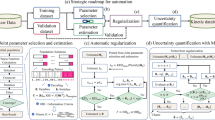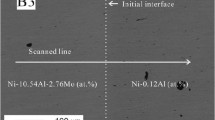Abstract
By solving the problems in the previous pragmatic method [Scr. Mater. 90-91, 53-56 (2014)] and including the interdiffusion flux as the criteria, an augmented numerical inverse method was proposed and realized in a house-made code. The proposed augmented numerical inverse method was successfully applied to high-throughput determination of the composition-dependent interdiffusivities in different solid solution alloys ranging from binary, ternary to multicomponent systems by using a single diffusion couple. Moreover, the advance features of the augmented numerical inverse method were also demonstrated.




Similar content being viewed by others
References
M.A. Dayananda and Y.H. Sohn: A new analysis for the determination of ternary interdiffusion coefficients from a single diffusion couple. Metall. Mater. Trans. A 30, 535 (1999).
R. Bouchet and R. Mevrel: A numerical inverse method for calculating the interdiffusion coefficients along a diffusion path in ternary systems. Acta Mater. 50, 4887 (2002).
A.V. Jaques and J.C. LaCombe: A stable and efficient regression approach for determination of coefficients in linear multicomponent diffusion. J. Phase Equilib. Diffus. 33, 181 (2012).
J.E. Morral and W.D. Hopfe: Validation of multicomponent diffusivities using one diffusion couple. J. Phase Equilib. Diffus. 35, 666 (2014).
S. Santra and A. Paul: Estimation of intrinsic diffusion coefficients in a pseudo-binary diffusion couple. Scr. Mater. 103, 18 (2015).
I.V. Belova, Y.H. Sohn, and G.E. Murch: Measurement of tracer diffusion coefficients in an interdiffusion context for multicomponent alloys. Philos. Mag. Lett. 95, 416 (2015).
L. Kaufman and J. Ågren: CALPHAD, first and second generation-birth of the materials. Scr. Mater. 70, 3 (2014).
G.B. Olson and C.J. Kuehmann: Materials genomics: from CALPHAD to flight. Scr. Mater. 70, 25 (2014).
G. Gottstein: Integral Materials Modeling: Towards Physics-Based Through-Process Models (Wiley-VCH Verlag GmBH&Co. KGaA, Germany, 2007).
W. Chen, L. Zhang, Y. Du, B. Huang, and C. Tang: A pragmatic method to determine the composition-dependent interdiffusivities in ternary systems by using a single diffusion couple. Scr. Mater. 90-91, 53 (2014).
H. Xu, W. Chen, L. Zhang, Y. Du, and C. Tang: High-throughput determination of the composition-dependent interdiffusivities in Cu-rich fcc Cu-Ag-Sn alloys at 1073 K. J. Alloys Compd. 644, 687 (2015).
J.S. Kirkaldy and D.J. Young: Diffusion in the Condensed State (The Institute of Metals, London, 1987).
J.R. Manning: Diffusion and the Kirkendall shift in binary alloys. Acta Metall. 15, 817 (1967).
W. Chen, L. Zhang, Y. Du, and B. Huang: Viscosity and diffusivity in melts: from unary to multicomponent systems. Philos. Mag. 94, 1552 (2014).
M.A. Dayananda: An analysis of concentration profiles for fluxes, diffusion depths, and zero-flux planes in multicomponent diffusion. Metall. Trans. A 114, 1851 (1983).
A. Ben Abdellah, J.G. Gasser, K. Bouziane, B. Grosdidier, and M. Busaidi: Experimental procedure to determine the interdiffusion coefficient of mis-cibility gap liquid alloys: case of GaPb system. Phys. Rev. 676, 174203 (2007).
J. Lechelle, S. Noyau, L. Aufore, A. Arredondo, and E. Audubert: Volume interdiffusion coefficient and uncertainty assessment for polycrystalline materials. Diffus.-Fundamentals.org. 17, 1 (2012).
J. Chen, C. Zhang, J. Wang, W. Chen, Y. Tang, L. Zhang, and Y. Du: Thermodynamic description, diffusivities and atomic mobilities in binary Ni-Os system. CALPHAD 50, 118 (2015).
W. Zhang: Thermodynamics and kinetic analysis of the formation of microstructure in multi-component graded cemented carbides and its experimental investigation. Ph.D. Thesis, Central South University, Changsha, 2015.
Acknowledgments
The financial support from the National Natural Science Foundation of China (Grant No. 51474239), National Natural Science Foundation for Youth of China (Grant No. 51301208) and the Hunan Provincial Natural Science Foundation for Youth of China (Grant No. 2015JJ3146) is acknowledged. Lijun Zhang acknowledges financial support from the project supported by State Key Laboratory of Powder Metallurgy Foundation, Central South University, Changsha, China. Weimin Chen acknowledges support by the outstanding graduate project of Advanced Non-ferrous Metal Structural Materials and Manufacturing Collaborative Innovation Center, Changsha, China.
Author information
Authors and Affiliations
Corresponding author
Supplementary material
Supplementary material
The supplementary materia for this article can be found at {rs|http://dx.doi.org/10.1557/mrc.2016.21|url|}.
Rights and permissions
About this article
Cite this article
Chen, W., Zhong, J. & Zhang, L. An augmented numerical inverse method for determining the composition-dependent interdiffusivities in alloy systems by using a single diffusion couple. MRS Communications 6, 295–300 (2016). https://doi.org/10.1557/mrc.2016.21
Received:
Accepted:
Published:
Issue Date:
DOI: https://doi.org/10.1557/mrc.2016.21




